Olympic Pools: Where Are They Now? (Part Four)
Full wall-to-wall Olympic coverage, including photo galleries, athlete interviews, recaps and columns are available at the Event Landing Page
Feature by Jeff Commings
PHOENIX, Arizona, July 26. IN our fourth in this five-part series looking at the history of the Olympic venues for swimming, we look at the five facilities that hosted the final five Olympics of the 20th century.
Click here to read Part Three.
At the 1980 Olympics in Moscow, the American-led boycott meant fewer athletes would get to experience the Olympijsky pool, which borrowed from the idea of the Montreal Olympics and coupled the design with another major building. In this case, it was the Olympic stadium, which hosted basketball and boxing events in two separate halls.
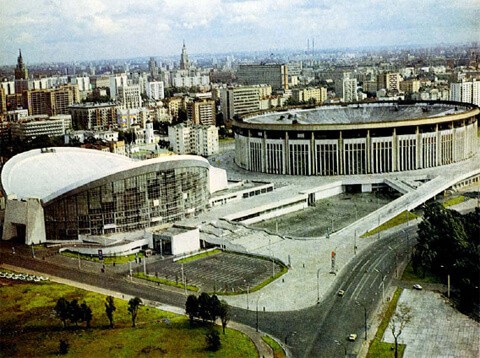
The swimming pool is on the left. The Olympic Stadium is on the right. (Photo courtesy IOC)
This new facility was built for the swimming competition, despite the fact that Moscow already had a suitable pool for Olympic swimming. It is unclear if FINA still had a policy that all Olympic swimming must be held outdoors in 1980, but as you can see from the photo below, the pool had adequate seating. Perhaps Montreal's introduction of a 10-lane Olympic pool was the catalyst for a new pool, as the existing pool only had eight lanes and the new pool featured 10.
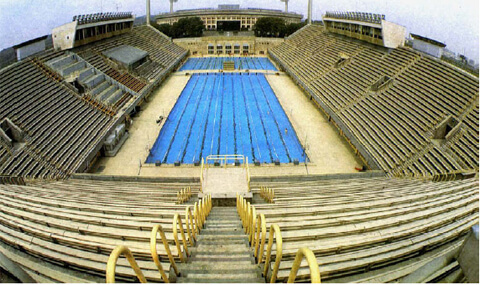
The outdoor pool was still used in the Olympics as the site of water polo matches, and got a few renovations to make it conform to FINA regulations. (Photo courtesy International Olympic Committee)
As for the new facility, a glass partition between the main competition pool and the diving well made it possible to stage both swimming and diving at the same time, something that had never been done before.
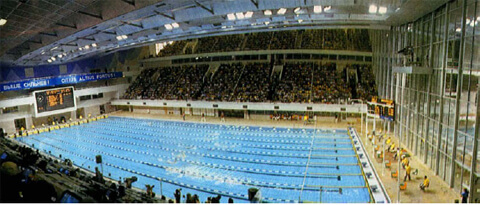
The glass partition is on the right of the photograph. (Photo courtesy IOC)
The Olympic competition pool and warm up pool are still in use today, with few changes. It hosts most of Russia's national championships, as well as the Moscow stop of the FINA World Cup.
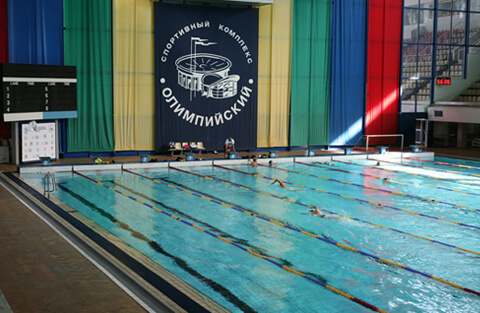
Even the glass partition is still in place, though covered by colorful drapes. (Photo courtesy Russian Swimming Federation
1984 Olympics, Los Angeles
Though the venue used as the main stadium for the 1932 Olympics was given a major renovation for track and field events, as well as the Opening and Closing ceremonies, the pool adjacent to the L.A. Coliseum was not picked to host swimming again in 1984. The layout of the pool no longer provided for enough spectator seating, nor was the facility adequate for competition. Organizers looked north for their answer, to the University of Southern California, where the athletic department was hungry for a new venue for its successful swimming teams.
The Olympic Swim Stadium received its funding from the fast-food chain McDonald's, though restrictions placed by the International Olympic Committee prevented the company from displaying its name on the building until after the Olympics, which it did and continues to do today.
The facility was built on the campus of the University of Southern California, and was the first Olympic outdoor swimming pool built in 24 years. (A FINA rule previously required all Olympic pools to be indoors.) At the time, the pool's moveable bulkheads were a unique feature, allowing the pool to be used for short-course and long-course competitions. Another unique feature was backstroke start handles built permanently into the ledge of the deck, instead of on the starting blocks.
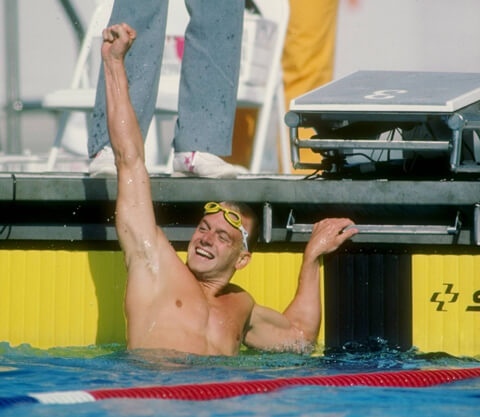
This iconic photo shows those unique backstroke grips. Rowdy Gaines is holding onto it here. (Photo courtesy Getty Images)
The only drawback to the pool was the return to eight lanes of competition instead of the 10 used in Montreal and Moscow. A little “breathing room” was put on the sides of the pool — about a couple of feet — to allow the placement of lane ropes along the walls to help ease wave turbulence. Most of the pool was the standard 2 meters deep, but at the starting end and extending out for about 10 meters, the pool depth was 3.96 meters, or 10 feet, deep.
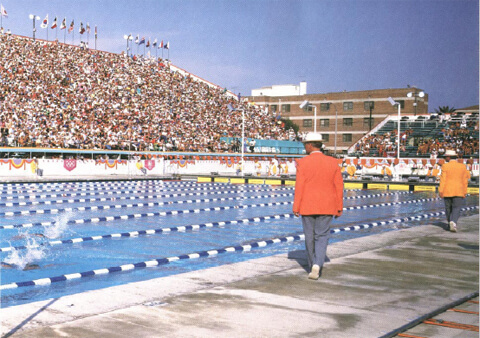
More than 16,000 people braved the Los Angeles heat in July to watch the United States take gold in nearly event. (Photo courtesy IOC)
USC continues to make the most of the McDonald's Swim Stadium, and it has become a popular competition pool. It hosted many regional and national competitions over the years, and is set for an $8 million renovation that will provide a new diving tower, locker rooms, spectator area with shade structures and a video scoreboard. The new facility will be named the Uytengsu Aquatics Center, after a former swimmer. The pool itself will be named the Peter Daland Pool, after the famed USC coach.
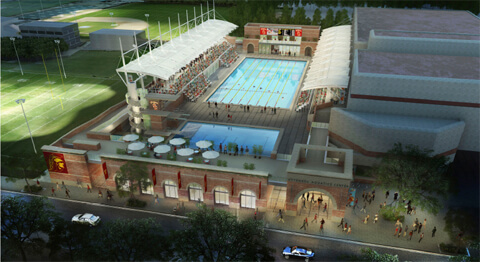
Above is an artist's rendering of the new facility. (Photo courtesy USC)
1988 Olympics, Seoul, Korea
The pool for the Seoul Olympics was missing a major feature of every Olympic pool since 1908. It did not have the flat walls that rise about a foot above the water surface at the start and turn ends. As such, photos from the meet show the touchpads — which were required to be a certain height above the water surface — anchored on the pool deck by a temporary plastic wall.
The ceiling contained large sunlights, which reduced the cost of lighting the facility. Like Los Angeles, the Seoul pool had varied depth, ranging from 2 to 3 meters, making it the deepest Olympic pool at the time. The Olympics also returned to using 10 lanes for competition.
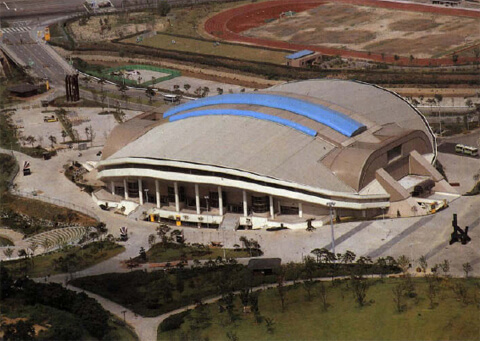
Notice the sunlights running the length of the facility. (Photo courtesy IOC)
All three pools built for the Olympics — the main competition pool, the long-course warm-up pool and the short-course warm-up pool — are still used regularly. The pool depth can be adjusted manually, allowing it to be used for competition, teaching or whatever the facility needs. (Photo courtesy Olympic Pool website)
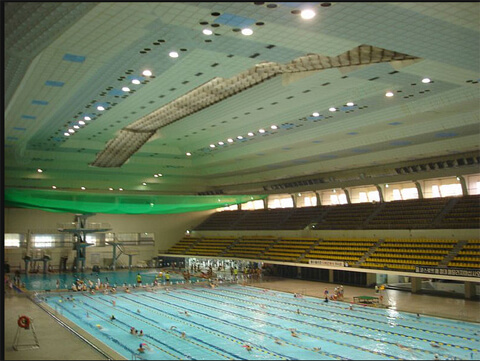
1992 Olympics, Barcelona
The Piscines Bernat Picornell complex was named after the founder of the Spanish swimming federation and was originally built for the 1970 European championships. When Barcelona was awarded the Games in 1986, the only major changes needed were to add temporary seating for the throng of spectators and cover the second long course pool, which was used for warm up and warm down. That pool is located in the building behind the main scoreboard.
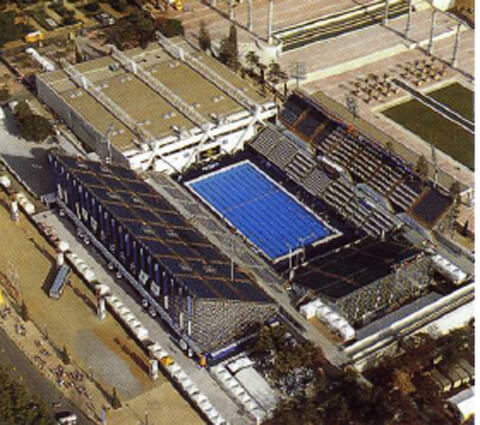
The renovations done to the pool included widening it to 25 meters and making the tank deeper — down to 3 meters. (Photo courtesy IOC)
The pool is now used mostly for recreational purposes, but often is where the Spaniards hold their national championships.
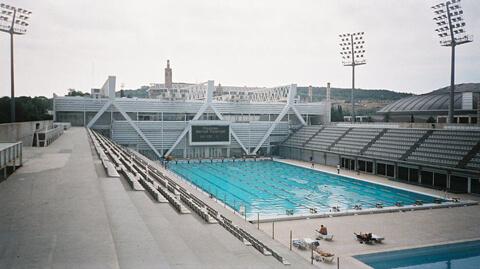
(Photo courtesy Wikipedia)
Barcelona will be the site of the 2013 FINA world championships, and as was the case in 2003, the swimming will not take place at the Bernat Picornell pool. It will be held instead inside the Palau Sant Jordi arena, which seats 12,000 people. The Bernat Picornell pool will be used for water polo at the world championships.
1996 Olympics, Atlanta
The architects behind the pool hosting the swimming in Atlanta apparently couldn't make up their minds about how to build the facility? Should it be an outdoor pool? Should it be indoors?
It appears no official determination was made, as the Georgia Tech Aquatic Center was open to the elements but also had a roof over the pool. Two sides of the building — the scoreboard end and the diving well end — had screens stretching from floor to ceiling. The spectator and press sections were under the roof structure but not supported by a wall.
The pool also featured a moveable floor that could set the pool depth to anywhere from zero to almost eight feet. (The pool depth was a constant 8 feet during the Olympics, to allow for the placement of a track on the bottom for video cameras, a first for swimming at the Olympics.)
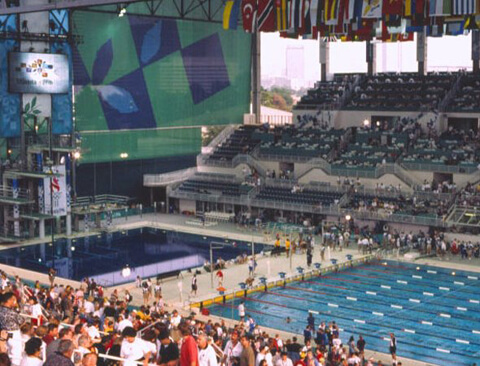
Humidity was high during the swimming competition in mid-July 1996, but breezes kept the facility from feeling too stuffy. (Photo courtesy IOC)
Not long after the Olympics, Georgia Tech decided to enclose the facility on all sides, with no changes made to the competition pool. The warm up pool used at the Olympics was the university's existing 50-meter pool, and that pool is still in use today. The aquatic center hosts USA Swimming nationals and other championship meets regularly. Its largest international meet since the Olympics was last December's Duel in the Pool, which featured the United States against Europe.
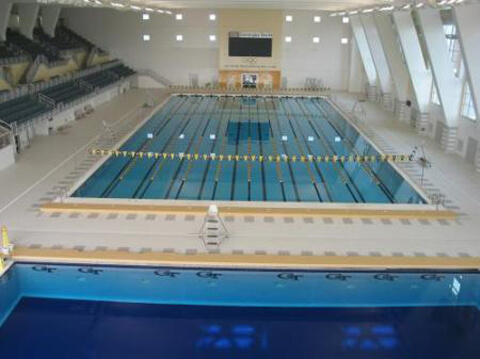
The facility continued to use the blocks from the 1996 Olympics until last year, when the new starting blocks with fins were retrofitted onto the existing supports. (Photo courtesy Georgia Tech University)
Up next: Concluding the series with a look at pools in Sydney, Athens and Beijing
Send feature story ideas to jeffc@swimmingworldmagazine.com.



